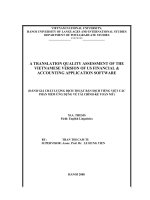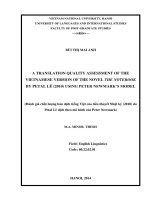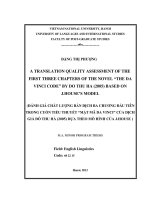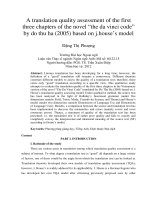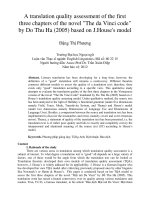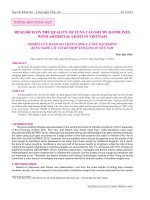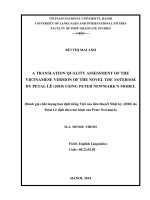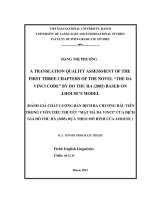a translation quality assessment of the vietnamese version of the nover the notebook by petal lê (2010) using peter newmark's model = đánh giá chất lượng bản dịch tiếng việt của tiểu thuyết nhật ký (2010) do petal lê
Bạn đang xem bản rút gọn của tài liệu. Xem và tải ngay bản đầy đủ của tài liệu tại đây (616 KB, 49 trang )
VIETNAM NATIONAL UNIVERSITY, HANOI
UNIVERSITY OF LANGUAGES AND INTERNATIONAL STUDIES
FACULTY OF POST-GRADUATE STUDIES
BÙI THỊ MAI ANH
A TRANSLATION QUALITY ASSESSMENT OF THE
VIETNAMESE VERSION OF THE NOVEL THE NOTEBOOK
BY PETAL LÊ (2010) USING PETER NEWMARK’S MODEL
(Đánh giá chất lượng bản dịch tiếng Việt của tiểu thuyết Nhật ký (2010) do
Petal Lê dịch theo mô hình của Peter Newmark)
M.A. MINOR THESIS
Field: English Linguistics
Code: 60.22.02.01
HANOI, 2014
VIETNAM NATIONAL UNIVERSITY, HANOI
UNIVERSITY OF LANGUAGES AND INTERNATIONAL STUDIES
FACULTY OF POST-GRADUATE STUDIES
BÙI THỊ MAI ANH
A TRANSLATION QUALITY ASSESSMENT OF THE
VIETNAMESE VERSION OF THE NOVEL THE NOTEBOOK
BY PETAL LÊ (2010) USING PETER NEWMARK’S MODEL
(Đánh giá chất lượng bản dịch tiếng Việt của tiểu thuyết Nhật ký (2010) do
Petal Lê dịch theo mô hình của Peter Newmark)
M.A. MINOR THESIS
Field: English Linguistics
Code: 60.22.02.01
Supervisor: Assoc. Prof. Dr. Lê Hùng Tiến
HANOI, 2014
DECLARATION OF AUTHORSHIP
I hereby state that the thesis entitled “A translation quality assessment of the
Vietnamese version of the novel The Notebook by Petal Lê (2010) using Peter
Newmark’s model” is the result of my research for the Degree of Master of Arts at
University of Languages and International Studies, Vietnam National University,
Hanoi, and the thesis has not been submitted for any degree at any other university or
tertiary institution.
Hanoi, 2014
Student
Bùi Thị Mai Anh
i
ACKNOWLEDGEMENTS
This study would not have been completed without the support of many people,
to whom I am profoundly grateful.
First and foremost, I would like to express my most sincere gratitude to Assoc.
Prof. Dr. Lê Hùng Tiến, my supervisor, for his invaluable advice, fervent guidance and
enthusiastic support during all the stages of this research. Without his advice and
indefatigable perseverance, I would not have been able to complete this paper.
Besides, I want to show my appreciation to my mother and my husband whose
encouragement represents the best inspiration I have ever had. Their energy and
enthusiasm always help me move forward, over tiredness and boredom when
everything seems to be in the middle of nowhere.
This experience would never have been my satisfaction, at least for now, without
my friends and colleagues who gave me helpful advice, suggestions and
encouragement during my exhaustion.
ii
ABSTRACT
This thesis examines the translation quality assessment of the Vietnamese
version of the novel The Notebook translated by Petal Lê. The Introduction states the
rationale for the study as well as establishes the objectives, scope and methods of the
study.
The main part of the thesis starts with the theoretical background which presents
issues relevant to the study comprising translation, translation methods, translation
equivalence and translation quality assessment. After all the theories have been
introduced, the researcher evaluates the Vietnamese version of the book using Peter
Newmark‟s model. The five-step model has been followed strictly with the emphasis
on step 3, also known as the heart of the critique.
In the last part of the study, the critic summaries what she has gained after
assessing the translation in order to answer the research questions set in the first part.
Suggestions for further studies are also offered.
iii
ABBREVIATIONS
SL: Source Language
TL: Target Language
ST: Source Text
TT: Target Text
iv
TABLE OF CONTENTS
DECLARATION OF AUTHORSHIP i
ACKNOWLEDGEMENTS ii
ABSTRACT iii
ABBREVIATIONS iv
PART A: INTRODUCTION 1
1. Rationale for the study 1
2. Objectives of the study 2
3. Scope and method of the study 2
3.1. Scope of the study 2
3.2. Method of the study 2
4. Design of the study 3
PART B: DEVELOPMENT 4
1. Theoretical Background 4
1.1. Translation Theory 4
1.1.1. Definition of Translation 4
1.1.2. Translation Methods 4
1.1.3. Translation Equivalence 5
1.1.3.1. Definition 5
1.1.3.2. Types of Equivalence 6
1.2. Translation Quality Assessment 8
1.2.1. Definition 8
1.2.2. Translation Quality Assessment Models 8
1.2.2.1. Juliane House‟s Model 8
1.2.2.2. Peter Newmark‟s Model 9
2. Evaluation of the Translation basing on Newmark’s Model 12
2.1. A brief analysis of the source language text 12
2.1.1. The author‟s purpose 12
2.1.2. Characteristic of the readership 12
2.1.3. The topic 12
2.2. The translator‟s interpretation 13
2.2.1. Omission of original text 13
2.2.2. The translator‟s method 16
2.2.3. The translation‟s likely readership 16
2.3. Comparison of the translation with the original 17
v
2.3.1. The title 17
2.3.2. The structure 18
2.3.2.1. Simple sentences vs. Compound sentences 18
2.3.2.2. Active vs. Passive voice 19
2.3.2.3. Order of clauses 24
2.3.2.4. Use of antonym 24
2.3.2.5. Change of subject 24
2.3.3. Proper names 25
2.3.3.1. People‟s names 25
2.3.3.2. Geographical names 26
2.3.3.3. Other names 27
2.3.4. Hierarchical pronouns as a cultural feature 28
2.3.5. Borrowed words 29
2.3.6. Puns 31
2.3.7. Some minor issues 32
2.3.7.1. Spelling mistakes 32
2.3.7.2. Mistranslation 32
2.3.7.3. Sentences that sound unnatural in the target language 34
2.4. An evaluation of the translation 35
2.5. Potential importance of the work within the target language culture 36
PART C: CONCLUSION 38
1. Concluding remarks 38
2. Suggestions for further studies 39
REFERENCES 40
vi
PART A: INTRODUCTION
1. Rationale for the study
As the acclaimed translator Edith Grossman writes in the Preface of her book Why
Translation Matters (2010), translation has a transcendent significance: “Translation not only
plays its important traditional role as the means that allows us access to literature originally
written in one of the countless languages we cannot read, but it also represents a concrete
literary presence with the crucial capacity to ease and make more meaningful our
relationships to those with whom we may not have had a connection before. Translation
always helps us to know, to see from a different angle, to attribute new value to what once
may have been unfamiliar. As nations and as individuals, we have a critical need for that kind
of understanding and insight. The alternative is unthinkable.” Literary translation, on the top
of that, is the one effective way to enhance intercultural understanding. Not every one has the
chance to know well even one foreign language to appreciate a literary work that they so
yearn for. It is translation and translators that fill the gap and open up new worlds for
booklovers to explore.
Globalization and integration have created great opportunity for a huge amount of
foreign literary works to come within reach of Vietnamese readers. While booklovers always
hunger for new literary works to come out, translators, at the same time, have to cope with
enormous workload of translating the originals as fast as possible. This makes translation a
demanding and tough job that requires not only broad cultural background knowledge but also
enthusiasm, professional conscience and scrupulousness. However, every now and then,
owing to objective and subjective reasons, the translated versions still contain mistakes of
various types. There are even translated works that cause translation disasters and spark off
vigorous debates. With thousands of literary translations published every year by hundreds of
publishers in Vietnam, translation quality control seems an impossible task. Besides highly
appreciated and well-received translation works such as Wuthering Heights and Gone with the
Wind by Dương Tường, Harry Porter series by Lý Lan, The Twilight Saga by Tịnh Thủy,
there remain works of poor quality, for example, the Vietnamese version of Harry Porter and
the Order of the Phoenix by Trần Thắng Minh (Văn hóa – Thông tin Publisher, 2003), The da
Vinci Code by Đỗ Thu Hà (Văn hóa – Thông tin Publisher, 2006), The Elementary Particles
by Cao Việt Dũng (Đà Nẵng Publisher, 2006), The Things They Carried by Trần Tiễn Cao
Đăng (Văn học Publisher, 2011), Seal Team Six by Đoàn Châu Hoài Giang (Alphabooks
Publisher, 2012). These translated versions have received a great deal of criticism since their
publication due to their vocabulary, grammar, style, spelling, typing mistakes that even an
1
ordinary reader cannot bear. Therefore, this minor thesis would like to concentrate on the
evaluation of one literary translation in order that readers and booklovers can have better
conception and comprehension of some models of translation quality assessment initiated by
notable linguists in the world such as Juliane House and Peter Newmark.
Since the limitation of a minor thesis, Juliane House‟s model and Peter Newmark‟s
model will be introduced and Newmark‟s will be selected as the main means to evaluate the
Vietnamese version of The Notebook by Petal Lê to reveal the good points and bad points of
the translated texts with regards to the original. In addition, the author would like to look into
the outstanding equivalence types the translator has achieved in translating this popular
literary work so that other translators can get some experience from him.
2. Objectives of the study
The study covers the following aims:
To assess the translation quality of the translated version of the novel The Notebook
in terms of the aspects discovered from theories raised by different scholars
including Juliane House and Peter Newmark with Newmark‟s model as the main
criteria
To suggest some implications for the translation of literary works
To successfully achieve the above aims, the thesis seeks to answer the two research
questions:
How good is the Vietnamese version of The Notebook according to Newmark‟s
model?
What recommendations can be made from the translated version?
3. Scope and method of the study
3.1. Scope of the study
The work of fiction The Notebook consists of twelve chapters in total. Since this is a
story of logical coherence and requires complete penetration, the researcher finds it is a good
idea to evaluate the translation text on a general basis. However, due to limitation of time for
this study, certain emphasis on highlights of this fiction will be presented.
3.2. Method of the study
Since this is the study to evaluate the translated version of The Notebook by Petal Lê, a
theoretical insight into some different translation quality assessment models by different
linguists is necessary. Peter Newmark‟s model, for its advantages in terms of applications,
will be used as the major criteria for evaluating the Vietnamese version of the novel.
2
The following steps will be taken. First, the original text will be read meticulously and
comprehensively. Secondly, the translated text will be read separately. Finally, the source text
will be compared to its translation under the framework of Newmark‟s translation quality
assessment model. According to his model, there are five main steps towards translation
quality assessment and they are going to be followed step by step.
Step 1: A brief analysis of the SL text stressing its intention and its functional
aspects
Step 2: The translator‟s interpretation of the SL text‟s purpose, his translation
method and the translation‟s likely readership
Step 3: A selective but representative detailed comparison of the translation with
the original in terms of both semantics and syntactic
Step 4: An evaluation of the translation
Step 5: Where appropriate, an assessment of the likely place of the translation in the
target language culture or discipline
4. Design of the study
The study consists of three main parts:
Part I: Introduction
This part shows the reason for choosing the topic, the objective as well as the scope and
method of the study.
Part II: Development
1. Theoretical Background
This part will discuss different basic aspects of translation, which is obligatory
background knowledge for any translation evaluator who would like to evaluate the quality of
translation, including definition of translation, translation methods, translation equivalence,
and translation assessment.
2. Evaluation of the Translation basing on Newmark‟s Model
In this part, Newmark‟s five-step translation quality assessment model aforementioned
will be applied in assessing the Vietnamese version of The Notebook by the well-known
author Nicholas Sparks.
Part III: Conclusion
The final part is the discussion of the results of this study. It concludes the strengths and
weaknesses of the translator basing on the application of the model. Suggestions and
implications for other translators are also offered, especially in the field of literary works.
3
PART B: DEVELOPMENT
1. Theoretical Background
1.1. Translation Theory
1.1.1. Definition of Translation
The term translation itself has several meanings: it can refer to the general subject field,
the product (the text that has been translated) or the process (the act of producing the
translation, otherwise known as translating). The process of translation between two
different written languages involves the translator changing an original written text (the
source text or ST) in the original verbal language (the source language or SL) into a written
text (the target text or TT) in a different verbal language (the target language or TL).
There are some definitions of translation. In Approaches to Translation, Newmark
(1982:7) states “Translation is a craft consisting in the attempt to replace a written message
and/or statement in one language by the same message and/or statement in another language.”
According to Bell, R.T (1991:5), “Translation is the expression in another language (or TL) of
what has been expressed in another, SL, preserving semantic and stylistic equivalences.”
Translation is the procedure which leads from a written SL text to an optimally
equivalent TL text, and which requires the syntactic, semantic, stylistic and text pragmatic
comprehension by the translator of the original text. (Wilss, 1982:112)
Translation is the replacement of a representation of a text in one language by a
representation of another equivalent in a second language. (Hartman & Stock, 1972)
Translation consists in reproducing in the receptor language the closest natural
equivalent of the source language message, first in terms of meaning and secondly in terms
of style. (Nida & Taber, 1974:12)
It is observed that the above definitions by different scholars in different times include
the two significant factors: the qualities of the original text covering meaning, style, syntactic
and pragmatic issues and the equivalence in the translation.
1.1.2. Translation Methods
Newmark (1988) suggests eight methods of translation as followed:
Source Language Emphasis Target Language Emphasis
Word-for-word translation Adaptation
Literal translation Free translation
Faithful translation Idiomatic translation
Semantic translation Communicative translation
Word-for-word translation: The SL word-order is preserved and the words translated
singly by their most common meanings, out of context. Cultural words are translated literally.
4
Literal translation: The SL grammatical constructions are converted to their nearest
TL equivalents but the lexical words are again translated singly, out of context.
Faithful translation: A faithful translation attempts to reproduce the precise contextual
meaning of the original within the constraints of the TL grammatical structures. It attempts to
be completely faithful to the intentions and the text-realization of the SL writer.
Semantic translation: Semantic translation differs from „faithful translation‟ only in as
far as it must take more account of the aesthetic value. It may translate less important cultural
words by culturally neutral third or functional terms but not by cultural equivalents. The
distinction between „faithful‟ and „semantic‟ translation is that the first is uncompromising
and dogmatic, while the second is more flexible, admits the creative exception to 100%
fidelity and allows for the translator‟s intuitive empathy with the original.
Communicative translation: Communicative translation attempts to render the exact
contextual meaning of the original in such a way that both content and language are readily
acceptable and comprehensible to the readership.
Idiomatic translation: Idiomatic translation reproduces the „message‟ of the original
but tends to distort nuances of meaning by preferring colloquialisms and idioms where these
do not exist in the original.
Free translation: Free translation reproduces the matter without the manner, or the
content without the form of the original. Usually it is a paraphrase much longer than the
original, a so-called „intra-lingual translation‟, often prolix and pretentious, and not translation
at all.
Adaptation: This is the „freest‟ form of translation. It is used mainly for plays and
poetry; the themes, characters, plots are usually preserved, the SL culture converted to the TL
culture and the text rewritten. (1988: 45-47)
1.1.3. Translation Equivalence
1.1.3.1. Definition
From the definitions of translation by different scholars, it is clear that equivalence is
the central issue in Translation Studies.
Andrew Chesterman, in Readings in Translation Theories (p100), describes that there
are “various categories of equivalence that have been proposed in the literature of translation
theory: content equivalence (often also: content invariance), stylistic equivalence, formal
equivalence, functional equivalence, textural equivalence, communicative equivalence,
pragmatic equivalence.” From the view point of Juliane House (1977:25), meaning
5
equivalence is the most essential in translation: “The essence of translation lies in the
preservation of meaning across two different languages.”
“SL and TL texts or items are translation equivalents when they are interchangeable in a
given situation,” (Catford, 1965:49)
Newmark (1995:48) states that “The overriding purpose of any translation should be to
achieve equivalent effect, i.e. to produce the same effect (or one as close as possible) on the
readership of the translation as was obtained on the readership of the original.” In this
statement, Newmark emphasizes the importance of functional equivalence as “the overriding
purpose of any translation.”
Koller cited in Readings in Translation Theory (Chesterman, A., 1989) views
equivalence in term of the maintenance of the SL and TT quality. According to him (1979),
the equivalence requirement of a translation to its origin is as follows: “Quality (qualities) X
in the source language text must be preserved.” The qualities can be understood as the
different characteristics the source text has, which must be preserved in the translation text.
These characteristics may include the style, meaning, readership and purpose of the text.
According to Baker, equivalence at word level covers a number of factors relating
number, gender, and part of speech. She claims that different grammatical structures in the SL
and TL may cause remarkable changes in the way the information or message is carried
across (noun phrase in SL can be translated as verb phrase in TT).
1.1.3.2. Types of Equivalence
Translation theorists tend to classify equivalence in accordance with different criteria
and approach. Some of the most outstanding ones are form-based, meaning-based, function-
based and quantitative equivalence.
1.1.3.2.1. Form-based Equivalence
An extremely interesting discussion of the notion of equivalence can be found in Baker
(1992) who seems to offer a more detailed list of conditions upon which the concept of
equivalence can be defined. She distinguishes between:
• Equivalence that can appear at word level and above word level, when translating from
one language into another. This means that the translator should pay attention to a number of
factors when considering a single word, such as number, gender and tense (1992:11-12).
• Textual equivalence, when referring to the equivalence between a SL text and a TL
text in terms of information and cohesion. It is up to the translator to decide whether or not to
maintain the cohesive ties as well as the coherence of the SL text. His or her decision will be
6
guided by three main factors, that is, the target audience, the purpose of the translation and the
text type.
1.1.3.2.2. Meaning-based Equivalence
Koller (1979) considers five types of equivalence:
• Denotative equivalence: the SL and the TL words refer to the same thing in the real world.
• Connotative equivalence: this type of equivalence provides additional values besides
denotative value and is achieved by the translator‟s choice of synonymous words or
expressions.
• Text-normative equivalence: The SL and the TL words are used in the same or similar
context in their respective languages.
• Pragmatic equivalence: With readership orientation, the SL and TL words have the
same effect on their respective readers.
• Formal equivalence: This type of equivalence produces an analogy of form in the
translation by their exploiting formal possibilities of TL, or creating new forms in TL.
1.1.3.2.3. Function-based Equivalence
Nida (1974) distinguishes formal equivalence and dynamic translation as basic
orientations rather than as a binary choice:
• Formal equivalence is achieved when the SL and TL words have the closest possible
match of form and content.
• Dynamic equivalence is achieved when the SL and TL words have the same effect on
their effective readers.
1.1.3.2.4. Quantitative Equivalence
On the word level, Hann (1992, in Baker, 2005:78) classifies equivalence relationships
into:
• One-to-one equivalence: A single expression in TL is equivalent to a single expression
in SL.
• One-to-many equivalence: More than one TL expressions are equivalent to a single SL
expression.
• Many-to-one equivalence: there is more than one expression in the source language
but there is a single expression in target language which is equivalence to them.
• One-to-part-of-one equivalence: A TL expression covers part of a concept designated
by a single SL expression.
• Nil equivalence: no TL expression is equivalent to a single SL expression, therefore,
loaned/borrowed equivalents should be used.
7
1.2. Translation Quality Assessment
1.2.1. Definition
In his book, A Textbook of Translation, Peter Newmark, naming translation quality
assessment as translation criticism, defines it as essential link between translation theory and
its practice.
Another scholar, Malcolm Williams at University of Ottawa, gives a more apparent
definition of translation quality assessment according to several aspects: evaluating sources
(their usefulness and authenticity), evaluating authors and their translators (their aesthetic,
their influences and how this informs their work), evaluating source texts and evaluating
target texts. Therefore, translation quality assessment is a type of evaluation. It can be
quantitative or qualitative: it can be based on mathematical/statistical measurement (as in the
case of most academic instruments) or on reader response, interviews and questionnaires (e.g.
Nida). Translation quality assessment can be diagnostic (determining areas for improvement
at the outset of a course of study), formative (measuring progress and giving feedback during
a course of study) or summative (measuring the results of learning). He finally concludes that
whether our focus is on products, performance or competence, we are essentially trying to
determine degrees of goodness when we perform translation quality assessment. The
approach can be prescriptive, assessing translation against criteria of aesthetic effect,
usability, and intrinsic compliance with standards of target language correctness and fidelity.
1.2.2. Translation Quality Assessment Models
Models of translation quality assessment have been proposed by a number of famous
authors such as Wilss (1974), Koller (1974), or Reiss (1974). Among them, Peter Newmark
(1995) and Juliane House (1997) are the two brilliant researchers who create their own
models to repair the deficiency and limitation of the preceding authors.
1.2.2.1. Juliane House’s Model
Juliane House‟s model was first designed in the mid-1970s (House, 1977, 2d.ed.1981)
and recently revisited (House, 1997).
In House‟s functional-pragmatic model of translation evaluation which is based on a
theory of translation as re-contextualization, translation texts are doubtly contextually bound:
to their originals and to the new recipients‟ contextual conditions. This double linkage is the
basis of the equivalence relation – the conceptual heart of translation. Since appropriate use of
language in communicative performance is what matters most in translation, it is functional
pragmatic equivalence which is crucial. This type of equivalence underpins this functional
8
translation model. The model explicates the way semantic, pragmatic and textual meaning are
re-constituted across different contexts.
– Translation is conceived as the replacement of an L1 text by a semantically and
pragmatically equivalent L2 text. An adequate translation is then a pragmatically and
semantically equivalent one.
– A first requirement for this equivalence is that a translation text has a function
equivalent to that of its original.
– The function of a text – with its ideational and interpersonal components – is simply
the application of a text in a particular context, and there is a systematic relationship between
context and the functional organization of language-in-text, which can be revealed by
breaking down context into a manageable set of „contextual parameters‟. To grasp a text‟s
meaning, it must be referred to the particular „context of situation‟ which envelops it.
Such a view of function and context-text underlies the analytic framework of the model.
According to Lê Hùng Tiến (2006), the model of translation quality assessment has a
clear linguistically theoretical base and concrete, detailed steps. However, this model also
requires linguistic knowledge and high professional skills of the critics and the criticism
mainly aims at researching languages and translation. Therefore, this model has not been
applied widely and just at experimental level in Translation Studies.
1.2.2.2. Peter Newmark’s Model
Peter Newmark made an attempt in 1988 to propound a theory of translation pedagogy
revolving around the notion of text. His theory is aimed at trainee students, and so his book,
entitled a textbook, has actually been chosen in many translation-teaching contexts. His model
of translation based on Nida and Taber‟s model. Newmark starts explaining his theory from
the question: what is translation? He suggests that it is often, but not always, rendering the
meaning of a text into another language in the way that the author intended the text. This
means the text is pulled in ten different directions:
1. The individual style or idiolect of the SL author
2. The conventional grammatical and lexical usage for the type of SL text, depending
on the topic and the situation
3. Content items referring specifically to the SL culture
4. The typical format of a SL language text in a book, periodical, newspaper, etc., as
influenced by the tradition at the time
9
5. The expectations of the putative readership, bearing in mind their estimated
knowledge of the topic and the style of language they use, expressed in terms of the largest
common factor
6. The conventional grammatical and lexical usage for the type of TL text, depending
on the topic and the situation
7. Content items referring specifically to the TL culture
8. The typical format of a TL text in a book, periodical, newspaper, etc., as influenced
by the tradition at the time
9. What is being described or reported, ascertained or verified
10. The views and prejudices of the translator, which may be personal and subjective,
or may be social and cultural
This can be visualized as followed:
(Carrové, 1999)
Newmark defines translation as the reproduction in the receptor language of the closet
natural equivalent of the source-language message, firstly in terms of meaning and secondly
in terms of style. This idealized definition of translation brings as a consequence a series of
polar distinction which force the translator to choose content as opposed to form, meaning as
opposed to style, equivalence as opposed to identity, the closest equivalence as opposed to
non-equivalence, and naturalness as opposed to formal correspondence. These decision-
1. SL
writer
2. SL
norms
3. SL
culture
4. SL setting &
tradition
10.
Translator
8. TL setting &
tradition
7. TL culture
6. TL
norms
5. TL
readership
9. The
truth
TEXT
10
making processes carry the misleading underlying message of ideal, one-to-one and perfect
matches between languages.
His theory is also based on an unrealistic three-level activity process, by which
translators receive, analyze the SL text and then transfer it into the TL. However, professional
translators and scholars alike have demonstrated that translators do not first receive and
analyze an SL text and then transfer it into the TL, but that the process of reception and
analysis operate according to the purpose of translation. Thus, the translator does not receive
and analyze the SL in a neutral way, but with a view to translating it for a certain purpose.
The eclectic approach proposes a five-step learning process of translation to help students
tackle the source text and its translation more confidently and with more and better arguments
to account for their decisions. Therefore, rather than getting students to proceed following a
linear structure (receive – analyze – transfer), they learn to approach the text from different
angles and perceive the different factors existing in the translation such as linguistic, extra-
linguistic, pragmatic or professional.
Newmark (1988) gives his own model of translation quality assessment called
“comprehensive criticism of a translation” including five practical steps which will be applied
in evaluating a specific translated version in this thesis.
Step 1: A brief analysis of the SL text stressing its intention and its functional aspects.
This may include a statement of the author‟s purpose, that is, the attitude he takes towards
the topic; characterization of the readership; an indication of its category and type.
Step 2: the translator‟s interpretation of the SL text‟s purpose, his translation method and
the translation‟s likely readership
Step 3: A selective but representative detailed comparison of the translation with the
original in terms of both semantics and syntactic. You do not take the points successively;
you group them selectively under general heads: the title; the structure, including the
paragraphing and sentence connectives; proper names; cultural words; shifty metaphors;
translationese; neologisms; „untranslatable‟ words; ambiguity; level of language; and,
where relevant, meta-language, puns, sound-effect.
Step 4: an evaluation of the translation: – (a) in the translator‟s terms, (b) in the critic‟s
terms, (c) as a piece of writing, independently of its original
Step 5: Where appropriate, an assessment of the likely place of the translation in the target
language culture or discipline. In the case of a serious text, say a novel, a poem, or an
important book, you assess the work‟s potential importance within the target language
culture.
11
2. Evaluation of the Translation basing on Newmark’s Model
In this part, the researcher evaluates the translated version of the novel The Notebook by
following five steps in Peter Newmark‟s model precisely as follows:
2.1. A brief analysis of the source language text
Newmark in his textbook states that “In your analysis of the SL text, you may include a
statement of the author‟s purpose, that is, the attitude he takes towards the topic;
characterization of the readership; an indication of its category and type. You assess the
quality of the language to determine the translator‟s degree of license, assuming for example
that he can reduce cliché to natural language in informative but not in authoritative texts. You
briefly state the topic or themes, but do not précis the text and do not „plot-monger‟ (painfully
retell the plot)” (1988:186). From this theory, the researcher will give a brief analysis of
statement of the author‟s purpose, characterization of the readership, and the topic of the
chosen literary work.
2.1.1. The author’s purpose
Review from the largest and most popular online retailer Amazon.com indicates that
Nicholas Sparks is one of the world‟s most beloved storytellers. All of his books have been
New York Times bestsellers, with nearly 80 million copies in print worldwide, in over 45
languages, including over 50 million copies in the United States alone, and his popularity
continues to soar. For this novel in particular, the author himself revealed, “The Notebook was
originally inspired by the story of my wife‟s grandparents. They had a rare and beautiful
relationship, one that withstood the test of time and circumstance. When I first met them, they
had been married over sixty years, and I remember marveling at how much they still seemed
to care for each other. The Notebook attempts to portray such a love. That said, The Notebook
is a novel, not a memoir. Many changes were made regarding their story, in order to make the
novel more universal, while staying committed to my original intent.”
2.1.2. Characteristic of the readership
The readership can be of large population. Any educated readers who like reading
books, especially love stories and romance, would certainly be interested in reading this
bestseller novel of The New York Times. The author of the novel has been so popular that
people who have already read his other novels would not miss the chance to read such a
classic story of love depicted in The Notebook. These readers may possess a great passion for
books, for understanding western culture, for enriching their own knowledge and souls.
2.1.3. The topic
12
The Notebook is a 1996 romantic novel by American novelist Nicholas Sparks, based on
a true story. There are various ideas about the topic or the theme of the novel, but the most
outstanding one is that true love can conquer all. The novel is a celebration of how passion
can be ageless and timeless, a tale that moves us to laughter and tears and makes us believe in
true love all over again.
2.2. The translator’s interpretation
In this second step, the researcher reviews whether the translator has omitted any
section of the original text and whether it affects the message that the author wishes to
express. In addition, the researcher also wishes to find out the translator‟s method and the
translation‟s likely readership.
2.2.1. Omission of original text
After the original novel and its translated version in Vietnamese by translator Petal Lê
are read and analyzed carefully, it is discovered that some phrases and sentences in the
original somehow have not been translated.
No
Original version
Translated version
1.
I am a common man with common
thoughts, and I‟ve led a common life.
There are no monuments dedicated to me
and my name will soon be forgotten…
(untranslated)
2.
Instead I slip it beneath my arm and
continue on my way to the place I must go.
Tôi kẹp nó dưới nách và đi tiếp đến chỗ
tôi cần phải đến. (p11)
3.
In my mind it‟s a little bit of both, and no
matter how you choose to view it in the
end, it does not change the fact that it
involves a great deal of my life and the
path I‟ve chosen to follow.
Trong tâm trí tôi, nó có chút gì đó của cả
hai, và dù cuối cùng bạn muốn nhìn nhận
thế nào thì cũng không thể thay đổi được
thực tế là nó liên quan rất nhiều đến cuộc
đời tôi và con đường tôi đã chọn. (p10)
4.
He knew he‟d spent almost his entire
savings on the house and would have to
find a job again soon,…
Anh biết mình đã tiêu gần hết các khoản
tiết kiệm vào ngôi nhà và sẽ sớm phải đi
tìm việc làm,… (p17)
5.
The seat had been slightly damp when
she sat down;…
Chỗ ngồi này hơi ẩm;… (p26)
6.
His years in the lumberyard had
toughened him to this type of labor, and
he worked hard.
Những năm tháng làm việc ở kho gỗ đã
khiến anh dày dạn với kiểu lao động này,
và anh rất chăm chỉ. (p37)
13
7.
Five weeks later he found himself in
boot camp. While there, he received a
letter from Goldman thanking him for his
work, together with a copy of a certificate
entitling him to a small percentage of the
scrap yard if it ever sold.
Năm tuần sau anh nhận được một bức thư
từ Goldman gửi lời cảm ơn vì những gì
anh đã làm, cùng một bản sao chứng
nhận cho phép anh hưởng mấy phần trăm
của bãi phế thải nếu nó được bán đi.
(p40)
8.
The house had changed dramatically
from what she remembered.
Ngôi nhà đã thay đổi đáng kể so với cô
còn nhớ. (p48)
9.
She stepped on the dock and it creaked
under her foot.
Cô bước lên cầu ra vụng thuyền, kêu cót
két dưới chân cô. (p66)
10.
She could feel his closeness, his warmth,
as she spoke.
Cô có thể cảm thấy sự gần gũi của anh,
hơi ấm của anh. (p68)
11.
How about cutting up some vegetables
for the fryer.
Cắt ít rau nhé. (p72)
12.
He answered as he made himself
comfortable.
Anh tìm tư thế ngồi cho thoải mái. (p75)
13.
By the way, I’ve been meaning to ask,
do you still paint?
À mà em còn vẽ không? (p82)
14.
It was so unexpected, yet uplifting, and as
the words began to replay in her mind,
she realized how sorry she would have
been had she decided not to see him again.
Điều ấy thật bất ngờ, mà cũng thật khích
lệ, cô nhận ra mình sẽ hối tiếc biết bao
nếu quyết định không gặp lại anh nữa.
(p109)
15.
She had known it once before, and again
she cursed herself for forgetting
something as important as creating beauty.
Trước đây cô đã từng biết, và lại một lần
nữa cô tự mắng mình vì đã quên một việc
quan trọng như việc tạo ra cái đẹp. (p132)
16.
Her feelings this morning had confirmed
it, and she knew that whatever happened,
she was going to give it another shot.
Những cảm giác cô có sáng nay đã khẳng
định điều đó, và cô biết rằng dù có gì xảy
ra thì cô cũng sẽ cho nó một cơ hội. (p132)
17.
I saw the article, too, and I saw your
reaction.
Mẹ đã đọc bài báo đó, và mẹ đã nhìn thấy
phản ứng của con. (p165)
18.
He kissed her gently, and they embraced
as they had when she first got out of her
car two days ago. Finally Allie let him go
and wiped her tears.
Anh nhẹ nhàng hôn cô và họ ôm chầm
lấy nhau như lần đầu tiên cô ra khỏi xe
hai ngày trước. (p176)
14
19.
She asks the obvious.
Bà hỏi. (p196)
20.
There‟s no way to tell how fast it will
progress… it differs from person to
person. …I wish I knew more.
Không có cách nào biết được nó sẽ tiến
triển nhanh hay chậm ra sao. (p207)
21.
I‟m strong and proud, and the luckiest
man alive, and I keep on feeling that way
for a long time across the table.
Tôi lại khỏe mạnh, tự hào, là người đàn
ông may mắn nhất còn sống, tôi cứ tiếp
tục cảm thấy thế một lúc lâu. (p235)
22.
„You can‟t see them?‟
„No,‟ I say, and she thinks for a moment.
(untranslated)
23.
I stand and cross the room to her bed.
Tôi đi ngang qua phòng đến giường bà.
(p239)
24.
I gently trace the outline of her cheek, then
take her hand in mine. I kiss her lips, her
cheeks, and listen as she takes a breath.
Tôi nhẹ nhàng lần tìm đường nét cằm bà
ấy, và lắng nghe khi bà ấy hít một hơi
sâu. (p267)
Example 1 is a prominent example of the translator‟s omission of the original text. The
whole two sentences have been left untranslated though they are preferred by many readers
and often quoted as their favorite. This section is at the beginning of the novel, and
supposedly, the translator might have been in a hurry and missed out the lines. This type of
blunder can also be found in examples 20 and 22. This remissness is unacceptable for a
literary translator.
In addition to leaving sentences untranslated, the translator seems to have overlooked
clauses and phrases in some other sentences. The illustration of this is observable in examples
5, 7, 10, 11, 12, 13, 14, 18, 19, 21 and 24. In examples 5, 7, 10, 12, 13, 14, 18 and 24, clauses
of the sentences have been omission with no translation in the Vietnamese version. Especially
in example 18, a whole sentence disappears in the translated version. Examples 11, 19 and 21
demonstrate the missing of some phrases in the sentences.
Last but not least, in his translated version, the translator has not translated some words
as well. These words may be of negligible significance, yet, some play the key role in
conveying the message from the author. Examples 2, 3, 4, 6, 8, 9, 15, 16, 17 and 23 are
evidence for this. In examples 2, 3 and 4, the untranslated words may be of minor importance;
however, in example 6, the translator has omitted the main verb of the clause; in example 8,
the relative pronoun what of the subordinate clause, making the translated sentence sound
irrational. Exceptionally, in example 9, the translator has excluded the subject of the second
clause, turning the sentence into one-subject sentence, therefore, making the translated text
15
sound incredibly funny. In example 15, the translator has eliminated the object it of the verb
known. Examples 16 and 17 have been translated with no translation of the word another and
too, therefore, not conveying fully the meaning of the sentence. Lastly, there are two verbs
stand and cross in example 23, however, the translated version has displayed only one verb
cross, with no mentioning of the verb stand.
From all the above-mentioned texts, it can be seen that the translator has unintentionally
or deliberately left out quite many words, phrases and even sentences in the translation of an
approximately-fifty-thousand-word novel. As pointed out above, along with the indication of
the missing translated texts, in some cases, the omission of the words or phrases has no
significant impact on the general meaning of the quoted sentences or paragraphs. The
translator may suppose that conveying the whole meaning of the passage is more important
than translating every word. And since the influence of this on the readers‟ understanding is
immaterial and the readers can still grasp the major gist of the text, this kind of translating is
still acceptable. However, it seems insupportable in other cases not translating the whole
sentences, which affects the sequence of understanding of readers who only have chance to
touch the Vietnamese version of the novel. This may result from literary translation where the
translator has to comply with the principles of the target language, hence, he might not be able
to maintain the format of the original version.
2.2.2. The translator’s method
People love reading Nicholas Sparks‟ books because they are simple and easy to read.
He uses language that is easily understood. Therefore, translating a Nicholas Sparks‟ work is
no hard job. This can be seen in the translated version by Petal Lê. Generally speaking, he has
stuck to the semantic translation method, making the content and language readily acceptable
and comprehensible to the readership. On the other hand, in a long work like a novel, the
complexity of word structures is inevitable; therefore, the translator surely has to combine
some methods of translation along with a chief method. Specifically, in this novel, literal
translation and faithful translation methods are also utilized.
2.2.3. The translation’s likely readership
Resembling the original, the translated version also aims at general readers who love
reading foreign literary works, especially love story and romance. From the methods and
language the translator has used, it can be suggested that the targeted readership is varied,
young and old, men and women, though usually young girls and women are those who show
more interest in finding this kind of book.
16
2.3. Comparison of the translation with the original
The third part, also considered as the heart of the study, will deal with how the
translator has solved the particular problems of the SL text (Newmark, 1988:187). The
evaluator will pick out the most selective and representative examples of the accomplishments
and shortcomings of the translated version in comparison with the original text. Then, they are
grouped under general heads: the title, the structure, proper names, cultural words (Newmark,
1988:187). A discussion of translation problems will also be presented.
2.3.1. The title
In Vietnam, titles of translated novels are often determined by the editorial staff of the
publishing house. In film, potential viewers determine whether they will watch a film or not
by some sense of the film narrative which starts with film titles (Hillman, 2011:388).
Similarly, titles of novels are crucial because they are the very first things that the potential
readers see and then put in their consideration of whether or not they will buy the novels.
There are some ideas about how to translate titles. Briffa and Caruana (2009:14 & 2)
pointed out the complexity of title translation because it is “governed by non-detachability,”
considering that “the title derives its identity from the context and translation must take this
into account.” Peter Newmark (1988:56) argued that the translated title “should usually bear
some relation to the original, if only for identification”, but it should also “sound attractive,
allusive, suggestive” to attract the potential readers.
Generally speaking, a translator is entitled to “change” the title of the text (Newmark,
1988:156). However, translating titles is not simple because the only true unit of translation
(the minimal stretch of language that has to be translated together, as one unit) is the whole
text (Newmark, 1988:54). The statement implies that, in translating a title, it is necessary to
consider the title as a part of the whole text. It is compulsory that a translator understands the
whole text before translating its title.
Newmark (1988:57 & 156) suggested that all titles are either descriptive (“which
describe the topic of the text”) or allusive (“which have some kind of referential or figurative
relationship to the topic”); the latter ones are suitable for imaginative literature, and may have
to be changed. However, for serious imaginative literature, Newmark (1988:57) thinks a
descriptive title should be “literally” kept, and an allusive title literally or, where necessary,
imaginatively preserved.
Titles of novels need to be attractive, allusive, and suggestive in order to catch the
attention of the readers. In order to do so, the titles should be able to attract the readers
emotionally because, as Nida and Taber (1974:91) stated, “we do not only understand the
17
